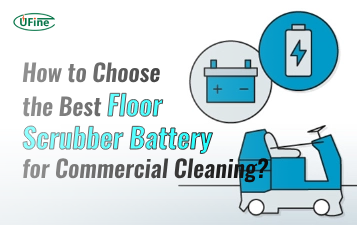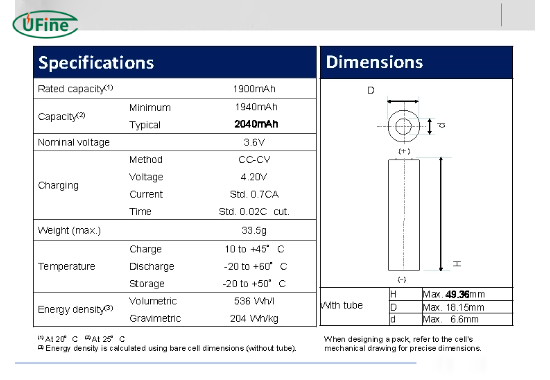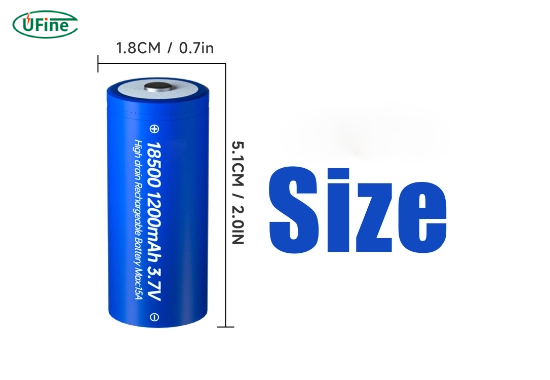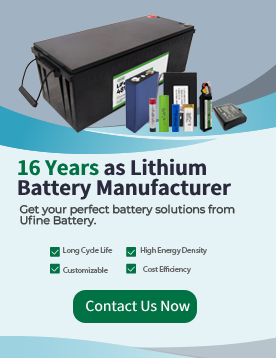The 18500 battery is a rechargeable lithium-ion battery widely used in various electronic devices. With its compact size and reliable performance, this battery type is a popular choice for flashlights, medical devices, and other portable gadgets.
In this article, we will explore the specifications, performance, and applications of the 18500 battery and answer common questions about its usage, advantages, and safety considerations.
Let’s dive in!
Part 1. What is an 18500 battery?
An 18500 lithium-ion (Li-ion) rechargeable battery has a diameter of 18mm and a length of 50mm. It is smaller than the 18650 battery but more significant than the 18350 battery, making it a versatile choice for medium-sized electronic applications.
Key specifications of an 18500 battery:
- Size: 18mm (diameter) × 50mm (length)
- Voltage: Typically 3.7V (nominal) and 4.2V (fully charged)
- Capacity: Ranges from 1000mAh to 2000mAh, depending on the brand and model
- Rechargeable: Yes, with lithium-ion chemistry
- Common applications: Flashlights, medical devices, power tools, and vaping devices
The 18500 battery is known for its balance between size and power, making it ideal for devices that require moderate energy without the bulk of larger batteries.
Part 2. How does an 18500 battery compare to other battery types?
It is helpful to compare the 18500 battery with other popular battery types. Here are some key points:
Compared to the 18650 battery:
- Size difference: The 18500 battery is slightly smaller than the 18650.
- Capacity: The 18650 battery often has a higher capacity, but the 18500 battery is ideal for compact applications.
- Usage: Both are used in similar applications, but the choice depends on the device size and energy needs.
Compared to AA batteries:
- Rechargeability: Unlike most AA batteries, the 18500 battery is rechargeable.
- Energy density: The 18500 battery offers higher energy density, meaning more power in a smaller package.
- Application: AA batteries are common in low-drain devices, while the 18500 battery fits high-drain, modern electronics.
Compared to lithium polymer (LiPo) batteries:
- Structure: The 18500 battery is cylindrical, while LiPo batteries are often flat and flexible.
- Safety: Lithium-ion batteries, including the 18500 battery, generally have robust safety features when appropriately used.
- Performance: LiPo batteries can have higher discharge rates, but the 18500 battery offers a good balance of capacity and stability.
Compared to nickel-metal hydride (NiMH) batteries:
- Voltage: The 18500 battery typically has a higher voltage (3.7V) than NiMH batteries (around 1.2V per cell).
- Capacity: The energy density is much higher in the 18500 battery.
- Maintenance: NiMH batteries require more careful charging and maintenance to avoid memory effects, whereas lithium-ion batteries have different management requirements.
Part 3. What are the advantages of an 18500 battery?
The 18500 battery offers several benefits compared to other battery types:
1. Compact and lightweight
The smaller size makes it ideal for portable devices without adding extra weight.
2. Rechargeable and long-lasting
Lithium-ion technology allows for hundreds of charge cycles, reducing the need for frequent replacements.
3. Stable voltage output
It provides a consistent 3.7V output, ensuring reliable electronic device performance.
4. High energy density
Lithium-ion batteries offer more power in a smaller package than NiMH or alkaline batteries.
5. Low self-discharge rate
It can retain charge for months when not in use, making it a great backup battery.
These advantages make the 18500 battery a preferred choice for many industries.
Part 4. What are the common applications of an 18500 battery?
The 18500 battery is found to be used in many different devices. Here are some common applications:
Consumer Electronics:
- Flashlights: The battery powers high-intensity LED flashlights, providing long-lasting light in a compact form.
- Portable Fans: It is used in small, rechargeable fans for personal cooling.
- E-cigarettes: Many e-cigarette devices use the 18500 battery due to its compact size and high performance.
Power Tools:
Some power tools and portable devices use the 18500 battery. Its high discharge rate is ideal for tools that need bursts of power.
Renewable Energy Systems:
The 18500 battery is sometimes used in small-scale renewable energy projects. It helps store energy from solar panels or wind turbines. Its stability and long cycle life are beneficial in these setups.
Medical Devices:
The 18500 battery is also used in compact medical devices. It provides reliable power for portable oxygen concentrators and diagnostic tools.
Automotive Applications:
While not as common in electric vehicles, the 18500 battery is sometimes used for backup power and auxiliary systems in automotive applications. Its compact size is an advantage in these roles.
Gadgets and Wearables:
The 18500 battery can be used in wearable technology, such as smartwatches and fitness trackers. The battery’s small form factor and reliable output suit these devices.
Part 5. How to safely charge and store an 18500 battery?
Charging tips
- Use a dedicated lithium-ion charger to prevent overcharging.
- Avoid cheap, unbranded chargers, as they may cause overheating.
- Do not charge near flammable materials.
Storage Tips
- Store in a cool, dry place away from direct sunlight.
- Keep away from metal objects to avoid short circuits.
- If stored for long periods, charge 50% before storage.
Following these safety tips will extend the lifespan of your 18500 battery and reduce risks.
Part 6. How long does an 18500 battery last?
The lifespan of an 18500 battery depends on usage and care.
Typical lifespan:
- Charge cycles: 300-500 cycles (1-2 years of regular use)
- Daily usage: Depending on the device, this can last several hours per charge.
Factors affecting lifespan:
- Overcharging or deep discharging can degrade the battery faster.
- High temperatures reduce battery efficiency.
- Using a compatible charger helps maintain battery health.
Proper care ensures that your 18500 battery lasts longer and performs optimally.
Part 7. Can you replace an 18500 battery with an 18650 battery?
No, an 18650 battery cannot directly replace an 18500 battery because:
- Size difference: The 18650 is longer (65mm vs. 50mm).
- Device compatibility: Devices designed for 18500 batteries may not fit larger batteries.
Always check your device’s battery requirements before replacing batteries.
Part 8. How to choose the best 18500 battery?
When selecting an 18500 battery, consider:
1. Capacity (mAh)
Higher capacity = longer runtime.
2. Brand Reputation
Choose trusted brands like Samsung, Panasonic, or LG.
3. Protection circuit
Some 18500 batteries come with a protection circuit to prevent overcharging.
4. Application needs
Ensure the battery matches your device’s voltage and power requirements.
Choosing the correct 18500 battery ensures optimal performance and safety.
Part 9. FAQs about 18500 batteries
What is the voltage of an 18500 battery?
Most 18500 batteries have a nominal voltage of 3.7V and a maximum charge of 4.2V.
Can I use an 18500 battery in a flashlight?
Yes, many flashlights are designed to use 18500 batteries for longer runtime and better performance.
Are all 18500 batteries rechargeable?
No, but most 18500 batteries are lithium-ion rechargeable. Always check the product label before purchasing.
How do I extend the life of my 18500 battery?
- Avoid overcharging or deep discharging.
- Store in a cool, dry place.
- Use a compatible charger.
What are the best brands for 18500 batteries?
The best brands include Samsung, Panasonic, Sony, and LG.
Related Tags:
More Articles

How to Choose the Best Floor Scrubber Battery for Commercial Cleaning?
Selecting the ideal floor scrubber battery ensures a long runtime, rapid charging, and minimal maintenance for efficient commercial cleaning operations.
Battery for Blower vs Battery for Leaf Vacuum: Which One Should You Choose?
Battery for blower vs leaf vacuum—learn the key differences in power, fit, and runtime to choose the right battery for your outdoor tool needs.
How to Choose the Right Battery for Blower?
Choosing the right blower battery? Consider voltage, capacity, chemistry & usage. This guide helps match the best battery for peak performance.
How to Choose the Best Insulated Battery Box for Lithium Batteries?
Choosing the Best Insulated Battery Box for Lithium Batteries? Discover key factors such as size, material, and safety for optimal protection and performance.
7 Critical Elements on a Lithium Battery Shipping Label
What must be on a lithium battery shipping label? Learn 7 key elements to ensure safety, legal compliance, and correct handling across all transport modes.





